Your chickens will need properly formulated chicken feed that is the correct type for their age, for growth, sustenance and to produce eggs if they are hens of egg laying age. There are many old wives tales and alternative views on feeding, some say it’s marketing that has created all of these feeds and hens will survive well on wheat and others will say their grandad never had layers pellets and just fed his hens kitchen scraps! Formulated poultry feeds didn’t exist until recently, primarily created thanks to commercial research on hens diets as we tried to squeeze more and more eggs out of hens.
In days gone by though when ‘grandad fed scraps’, pure breeds were kept for eggs and they were fed grain mixes or dried mash chicken feed that had meat or fish meal added to increase the protein content. Hens would free range over a large area and could also supplement their diet with what they could forage. Bugs, insects and worms are all valuable sources of protein, not forgetting a good selection of greens providing vitamins and minerals.
“Grandad’s chickens didn’t get chicken feed and survived on kitchen scraps but they could free range to top up their diet on protein, vitamins, minerals and calcium from the fields or orchards they grazed. They didn’t produce anything like the number of eggs modern hybrid hens or some pure breeds produce.”
So in short, if you don’t feed a proper formulated layers feed to your hens, they won’t be able to keep up the demands that egg-laying puts on their bodies.
Layers Feeds and Protein
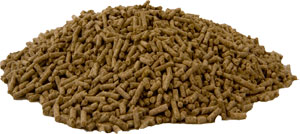 Chickens require protein to produce feathers and eggs as well as to grow. The amount of protein in their diet is important and you will see on the ingredients on the back of bags of commercial feeds the percentage of protein that they contain. It is higher in ‘Growers Pellets’ for example to enable chickens to grow and produce feathers. You will find that chickens stop laying eggs when they moult (lose their feathers and regrow new) as they are diverting protein from egg production to feather production. During the moult, you can scatter a handful of cat kibble in the run which helps them to top up with protein. Do not use dog food as most of the protein is derived from cereals.
Chickens require protein to produce feathers and eggs as well as to grow. The amount of protein in their diet is important and you will see on the ingredients on the back of bags of commercial feeds the percentage of protein that they contain. It is higher in ‘Growers Pellets’ for example to enable chickens to grow and produce feathers. You will find that chickens stop laying eggs when they moult (lose their feathers and regrow new) as they are diverting protein from egg production to feather production. During the moult, you can scatter a handful of cat kibble in the run which helps them to top up with protein. Do not use dog food as most of the protein is derived from cereals.
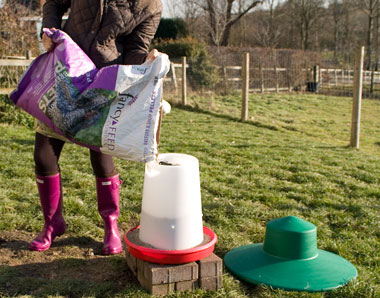
Commercial feeds contain the right balance of nutrients & can be fed ad-lib in hoppers if kept dry. This one has a rain hat.
Commercial chicken feeds have been well researched and contain the correct balance of minerals and nutriets required by chickens as well as sufficient protein and calcium which is essential for egg shell production. Layers pellets for example are around 16% protein. Wheat is about 10% protein and lacks essential vitamins that are required by chickens.
Formulated feeds come as pellets or mash and should be fed ad-lib so hens can take what they want as they need it. This type of feed must be kept dry or it will soon spoil. The feeder and rain hat shown above is the only sort I have found that really does keep the feed dry. Most have a hole in the top of the hat for a handle or for hanging and this lets water in. A feeder and rain hat similar to this one can be bought from Omlet.
Eggs are made up of around 80% protein so if there’s a shortage of protein in their diet, egg laying will be the first thing they your girls cut back on!
There is more information on the poultykeeper.com site which has a very good page of feeding chickens and chicken feed.
Mixed corn
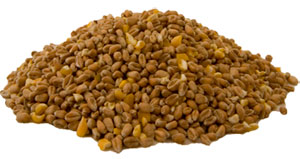 Mixed corn is usually 80 to 90% wheat and 10 to 20% maize. It is useful as a scratch feed, it keeps hens active, scratching around looking for it but should only be considered a treat. A handful per hen thrown late afternoon helps them to have a full crop overnight.
Mixed corn is usually 80 to 90% wheat and 10 to 20% maize. It is useful as a scratch feed, it keeps hens active, scratching around looking for it but should only be considered a treat. A handful per hen thrown late afternoon helps them to have a full crop overnight.
The maize (yellow in colour) is very fattening but can be useful during very cold weather to help your hens keep warm – I increase my girls’ ration of corn when it is cold over the winter, after they have finished moulting (they need lots of protein during the moult) since they are not laying eggs and need a little extra fat to burn in order to keep warm.
If you feed too much corn, your hens will get fat and fat hens don’t lay eggs!
Household scraps
Feeding household scraps is no longer allowed according toi DEFRA and can be a bit hit and miss anyway. You don’t really know what a hen is getting and the diet is very unbalanced. It is for this reason that scraps used to be mixed into a mash by using layers mash and water (which can be warm in winter). The mixture should be a sort of crumbly mix, not too wet but not too dry. Feeding scraps should be limited to at most 25% of a hens diet so as not to tip the balance too far one way or another.
Greens
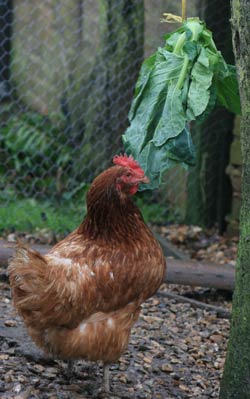 Ample green stuff should be provided for your hens. Grass cuttings, weeds and off-cuts from cabbages, cauliflowers and other greens can be provided at minimal cost. Lettuce should be fed in moderation because it has very little nutritional value (very little Protein and Energy / Calories) and avocado pear is poisonous to hens but most other greens that come from the kitchen will be appreciated by your girls. Try hanging greens in their run, just a little higher than they can reach. As they eat them, they will need to jump to get the last bits so will be getting exercise at the same time as their greens! Win-win!
Ample green stuff should be provided for your hens. Grass cuttings, weeds and off-cuts from cabbages, cauliflowers and other greens can be provided at minimal cost. Lettuce should be fed in moderation because it has very little nutritional value (very little Protein and Energy / Calories) and avocado pear is poisonous to hens but most other greens that come from the kitchen will be appreciated by your girls. Try hanging greens in their run, just a little higher than they can reach. As they eat them, they will need to jump to get the last bits so will be getting exercise at the same time as their greens! Win-win!
If you have an area in which you can grow cabbages in your garden, it may be worthwhile thinking about growing a row for the winter. Cabbages will sit there in the cold, perfectly preserved until picked. You will need to keep them covered with fleece when there are cabbage white butterflies around but don’t worry if they are a little eaten, the chooks won’t mind!
Mealworm treats
Many chicken keepers like to buy mealworms or chicken treats containing these. Chickens love these and are easily tamed by using such tasty treats, however you should keep in mind that animal by-product regulations mean that mealworms are not really allowed to be fed to poultry.

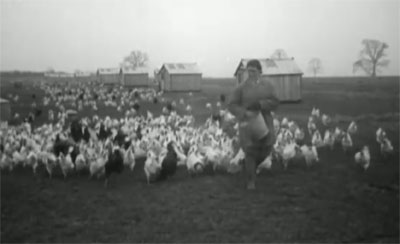

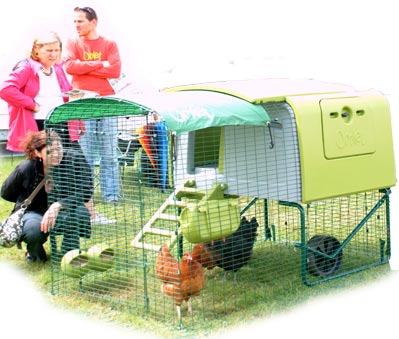


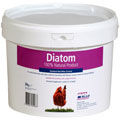
Hi,
I am thinking of buying some chickens, but not so much for eggs as to protect my large vegetable garden from slugs. I’ve heard that in permaculture philosophy chickens are supposed to be an essential part of the eco balance.
I’m not sure how can I teach them to find slugs or weather I should collect the slugs myself and then feed them to the chickens, so that they don’t dig up my garden. Do you have any advice on slugs as feed? And do you think it is a good idea to let the chickens run free in a large garden. I’m afraid I won’t be able to make them come to their coop for the night.
Thank you in advance for your help!
M
Chickens will unfortunately eat your plants and cause lots of damage through scratching.
Ducks on the other hand will not scratch, or cause damage to your plants and they love insects and slugs. Just keep water puddles away from the vegetable garden or it will all turn into mud with their dabbling and they will fit in very well. They won’t put themselves to bed but will stay in a flock and heard very easily. Simply hold your arms out and walk towards them moving left or right and they will go in the opposite direction. This way you can guide them in to their house easily. Make sure their house has a wide door as they all try to go in together.
Would you recommend layers pellets or layers mash as a normal everyday feed for three pol hens that spend the day free ranging? Thanks
Either are fine. Most people feed pellets due to convenience and ease of getting them from suppliers. Sometimes mash can get wasted on the floor as hens pick through it. Mash can be slightly cheaper.
Hi
We are thinking of buying 3 chickens but have been told that we should possibly wait until spring. Apparently, if we buy now, they may not lay well and this could continue but, if we buy in the spring we would have more eggs.
How true is this? Should we go ahead or wait?
We are possibly going to get an Oxford blue, Oxford brown and The Amber – a good mix or should they all be the same?
Thanks in advance of your help.
If the birds are available in the spring at the same price, I would get them then. In the case of pure breeds, they usually aren’t available until later in the year and nobody wants to grow birds over the winter when it costs more and grass isn’t available but for hybrids that are mass produced, it’s possibly not going to make too much difference. Do check with the supplier though.
The egg production depends on their age – typical point of lay (POL) birds are actually a good few weeks off laying when you buy them anyway and birds don’t usually lay over the darker days of winter but youngsters that don’t start laying because of this over the winter will lay bigger eggs when they start laying.
Hi,
I keep quite a few chickens and actually breed Cream Legbars. They are all kept in large open runs surrounded by electric fencing, but I do let them come out in the afternoon for a couple of hours to totally free range. My question is – is it ok to feed chickens; Marrow, Pumpkin and Courgette? We have a surplus and rather than throw them on the muck heap, I would rather let the hens have them. I just want to be sure that they are not poisonous to chickens.
Thanks.
To be honest, I don’t know but I would guess they should be fine. The biggest danger is upsetting their diet, their protein levels would drop and eggs are mainly protein…. so you can guess what could happen if they are laying.
Thanks to all who have contributed to a very interesting thread. We have 30 girls, 26 of them ex-batts rehomed in June and July. They have one definite cockerel for company, and another that seems confused, jumping other chooks one minute and sitting in a nest box the next!
They have a stable to themselves at night and have the run of the paddock and garden in the day. Like others, we have given up on layer’s pellets in favour of mash, with a bit of mixed corn and/or sunflower seeds for supper.
Egg production peaked at about 12-14 a day through the late summer and then tailed off, but has now surged again, 18 and 17 last two days. Not sure what if anything I am doing right, maybe it’s just that in Kent it has been such a benign Autumn, bone dry and hardly a touch of frost yet. But we have been leaving the stable light on in the evening so they can scratch around in the straw for a few hours (most still seem content to roost but they have the option). Is that likely to have had any effect on the laying pattern?
Second questions concerns soft shells where I am still finding the odd surviving egg with very thin shell or, more often, evidence of one that has been devoured! We have a container of oystershell grit left where they can all get at it – is there anything else we should be doing to encourage healthy shells?
Yes, light hitting the petuitary gland in the back of the eye is what regulates laying. Once the daylight hours drop, the hens stop laying but if you provide extra light, they will increase egg production.
Shell quality can vary and you will find with Ex Bats they will deteriorate as they age quite dramatically. They have after all been bred to produce as many eggs as possible in the first 18 months of their life and the quantity of eggs they lay is abnormal compared to pure bred hens.